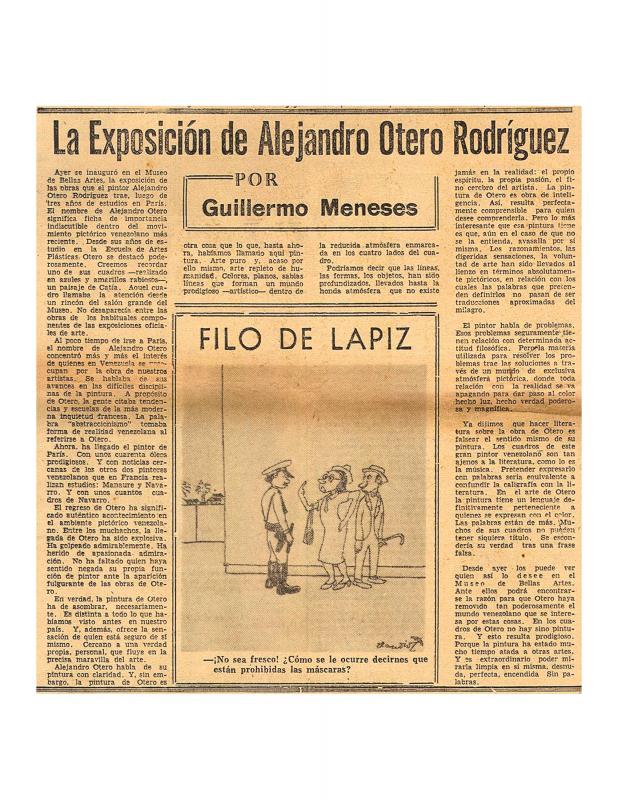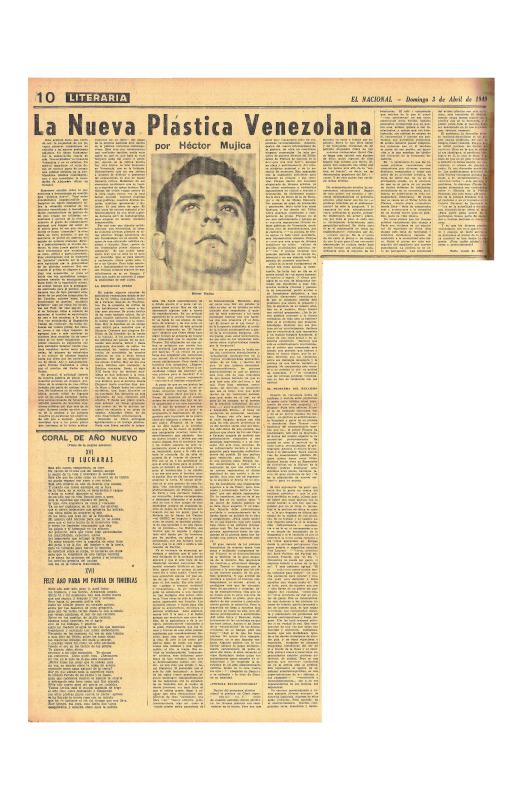The objective of this article by the curator María Elena Ramos (b. 1947) about the work of Alejandro Otero (1921–90) is to ignore the conventional concept of “structure” (which is merely a visual-formal issue) in order to glimpse a perceptible approach (haptic and factic) that is not merely representational. According to Ramos, Otero pursues this same goal both by doing away with the pictorial object and by expressing it in its three-dimensional form. She thus indicates the constructive nature of reality; that is, of the elements that are “outside” the work (in this case, monumental); wind, light, water. Ramos recalls Otero’s ideas about a “dynamic space” that was susceptible to experimentation. She ultimately classifies those resources, not just as expressive instruments, but as language codes, podiums for an aesthetic approach that is both variable and totalizing. The “work’s structure” therefore refers to the structure of the surrounding world.
As regards Otero’s career, this essay includes a review of a grand retrospective exhibition of his work—at the Museo de Arte Contemporáneo de Caracas in 1985—that solidified his standing in the Venezuelan art world. In 1982 Otero represented Venezuela at the Biennale di Venezia and then, in 1987, he went to Cambridge (Boston) to do research at MIT (Massachusetts Institute of Technology). At that time his public sculptures were installed all over Caracas; the result of a project based on his experimentation with the idea of “structure.” Ramos thought deeply about the exhibition Alejandro Otero: las estructuras de la realidad (Caracas: Museo de Bellas Artes, 1990), which was subsequently shown at the Museo de Arte Moderno Jesús Soto in Ciudad Bolívar.
To read other critical articles about Otero’s work, see by J. R. Guillent Pérez (also a member of the Los Disidentes group) “Realidad e irrealidad. El postigo de Alejandro Otero” [doc. no. 1172158]; by Guillermo Meneses “La exposición de Alejandro Otero Rodríguez” [doc. no. 1097092]; by Roberto Guevara “La vertical vibrante de Maracay, 1968” [doc. no. 1168201]; the essay by François Sego from the catalogue for the exhibition Alejandro Otero (1949) [doc. no. 850732]; the article by Héctor Mujica “La nueva plástica venezolana” [doc. no. 850512]; the article by María Elena Ramos “Alejandro Otero: indagar en las estructuras de la realidad” [doc. no. 1167733]; the review by Ernesto Guevara “Sólo quisiera ser puntual. El tiempo en la pintura de Alejandro Otero” [doc. no. 1163813]; the essay by Damián Bayón “El espacio dinámico en la obra de Alejandro Otero” [doc. no. 1167828]; the articles by Juan Calzadilla “Exposiciones en Caracas: Alejandro Otero - Galería Mendoza” [doc. no 1172174] and “Alejandro Otero y la enseñanza del arte” [doc. no. 1167940]; the article by Miguel Otero Silva “Sobre unas declaraciones disidentes del pintor Alejandro Otero Rodríguez” [doc. no. 813737]; and, finally, the reviews by José Ratto-Ciarlo “En pro y en contra de Alejandro Otero” [doc. no. 850770] and Juan Carlos Palenzuela “Una conciencia de arte latinoamericano” [doc. no. 1163142].













